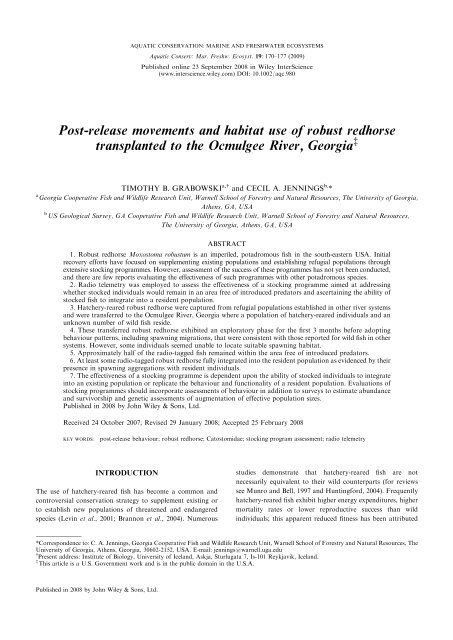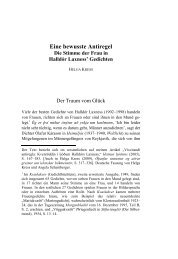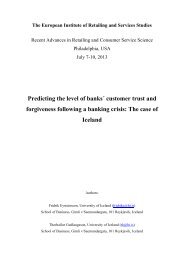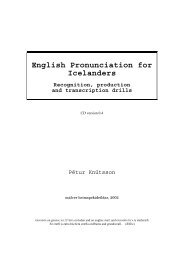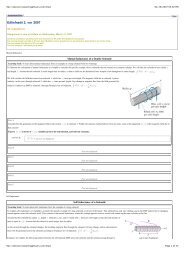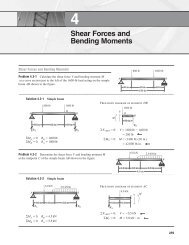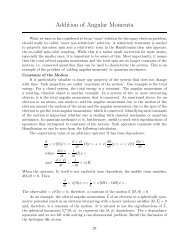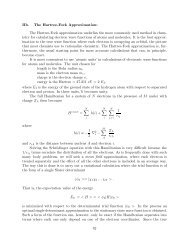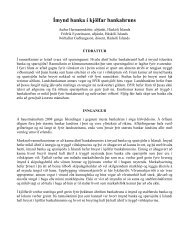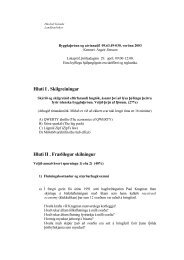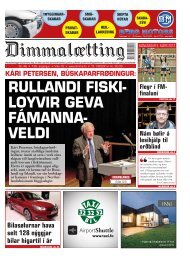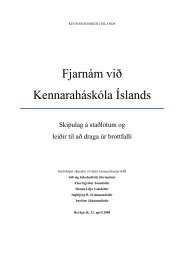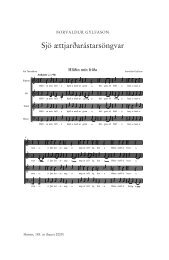Post-release movements and habitat use of robust redhorse ...
Post-release movements and habitat use of robust redhorse ...
Post-release movements and habitat use of robust redhorse ...
Create successful ePaper yourself
Turn your PDF publications into a flip-book with our unique Google optimized e-Paper software.
AQUATIC CONSERVATION: MARINE AND FRESHWATER ECOSYSTEMS<br />
Aquatic Conserv: Mar. Freshw. Ecosyst. 19: 170–177 (2009)<br />
Published online 23 September 2008 in Wiley InterScience<br />
(www.interscience.wiley.com) DOI: 10.1002/aqc.980<br />
<strong>Post</strong>-<strong>release</strong> <strong>movements</strong> <strong>and</strong> <strong>habitat</strong> <strong>use</strong> <strong>of</strong> <strong>robust</strong> <strong>redhorse</strong><br />
transplanted to the Ocmulgee River, Georgia z<br />
TIMOTHY B. GRABOWSKI a,y <strong>and</strong> CECIL A. JENNINGS b, *<br />
a<br />
Georgia Cooperative Fish <strong>and</strong> Wildlife Research Unit, Warnell School <strong>of</strong> Forestry <strong>and</strong> Natural Resources, The University <strong>of</strong> Georgia,<br />
Athens, GA, USA<br />
b<br />
US Geological Survey, GA Cooperative Fish <strong>and</strong> Wildlife Research Unit, Warnell School <strong>of</strong> Forestry <strong>and</strong> Natural Resources,<br />
The University <strong>of</strong> Georgia, Athens, GA, USA<br />
ABSTRACT<br />
1. Robust <strong>redhorse</strong> Moxostoma <strong>robust</strong>um is an imperiled, potadromous fish in the south-eastern USA. Initial<br />
recovery efforts have foc<strong>use</strong>d on supplementing existing populations <strong>and</strong> establishing refugial populations through<br />
extensive stocking programmes. However, assessment <strong>of</strong> the success <strong>of</strong> these programmes has not yet been conducted,<br />
<strong>and</strong> there are few reports evaluating the effectiveness <strong>of</strong> such programmes with other potadromous species.<br />
2. Radio telemetry was employed to assess the effectiveness <strong>of</strong> a stocking programme aimed at addressing<br />
whether stocked individuals would remain in an area free <strong>of</strong> introduced predators <strong>and</strong> ascertaining the ability <strong>of</strong><br />
stocked fish to integrate into a resident population.<br />
3. Hatchery-reared <strong>robust</strong> <strong>redhorse</strong> were captured from refugial populations established in other river systems<br />
<strong>and</strong> were transferred to the Ocmulgee River, Georgia where a population <strong>of</strong> hatchery-reared individuals <strong>and</strong> an<br />
unknown number <strong>of</strong> wild fish reside.<br />
4. These transferred <strong>robust</strong> <strong>redhorse</strong> exhibited an exploratory phase for the first 3 months before adopting<br />
behaviour patterns, including spawning migrations, that were consistent with those reported for wild fish in other<br />
systems. However, some individuals seemed unable to locate suitable spawning <strong>habitat</strong>.<br />
5. Approximately half <strong>of</strong> the radio-tagged fish remained within the area free <strong>of</strong> introduced predators.<br />
6. At least some radio-tagged <strong>robust</strong> <strong>redhorse</strong> fully integrated into the resident population as evidenced by their<br />
presence in spawning aggregations with resident individuals.<br />
7. The effectiveness <strong>of</strong> a stocking programme is dependent upon the ability <strong>of</strong> stocked individuals to integrate<br />
into an existing population or replicate the behaviour <strong>and</strong> functionality <strong>of</strong> a resident population. Evaluations <strong>of</strong><br />
stocking programmes should incorporate assessments <strong>of</strong> behaviour in addition to surveys to estimate abundance<br />
<strong>and</strong> survivorship <strong>and</strong> genetic assessments <strong>of</strong> augmentation <strong>of</strong> effective population sizes.<br />
Published in 2008 by John Wiley & Sons, Ltd.<br />
Received 24 October 2007; Revised 29 January 2008; Accepted 25 February 2008<br />
KEY WORDS: post-<strong>release</strong> behaviour; <strong>robust</strong> <strong>redhorse</strong>; Catostomidae; stocking program assessment; radio telemetry<br />
INTRODUCTION<br />
The <strong>use</strong> <strong>of</strong> hatchery-reared fish has become a common <strong>and</strong><br />
controversial conservation strategy to supplement existing or<br />
to establish new populations <strong>of</strong> threatened <strong>and</strong> endangered<br />
species (Levin et al., 2001; Brannon et al., 2004). Numerous<br />
studies demonstrate that hatchery-reared fish are not<br />
necessarily equivalent to their wild counterparts (for reviews<br />
see Munro <strong>and</strong> Bell, 1997 <strong>and</strong> Huntingford, 2004). Frequently<br />
hatchery-reared fish exhibit higher energy expenditures, higher<br />
mortality rates or lower reproductive success than wild<br />
individuals; this apparent reduced fitness has been attributed<br />
*Correspondence to: C. A. Jennings, Georgia Cooperative Fish <strong>and</strong> Wildlife Research Unit, Warnell School <strong>of</strong> Forestry <strong>and</strong> Natural Resources, The<br />
University <strong>of</strong> Georgia, Athens, Georgia, 30602-2152, USA. E-mail: jennings@warnell.uga.edu<br />
y Present address: Institute <strong>of</strong> Biology, University <strong>of</strong> Icel<strong>and</strong>, Askja, Sturlugata 7, Is-101 Reykjavik, Icel<strong>and</strong>.<br />
z This article is a U.S. Government work <strong>and</strong> is in the public domain in the U.S.A.<br />
Published in 2008 by John Wiley & Sons, Ltd.
to both their naivete´ <strong>and</strong> unfamiliarity with the local<br />
environment, such as the location <strong>of</strong> refuge, foraging, <strong>and</strong><br />
spawning <strong>habitat</strong>s (Cresswell, 1981; Helfrich <strong>and</strong> Kendall,<br />
1982; McGinnity et al., 2004); the presence <strong>of</strong> predators or<br />
competitors (Olla et al., 1998; Kellison et al., 2000; Bettinger<br />
<strong>and</strong> Bettoli, 2002; Schooley <strong>and</strong> Marsh, 2007); <strong>and</strong> fluctuating<br />
or unfamiliar abiotic conditions (Bettinger <strong>and</strong> Bettoli, 2002;<br />
Ward <strong>and</strong> Hilwig, 2004). The differences in performance <strong>and</strong><br />
survival between hatchery-reared individuals <strong>and</strong> their wild<br />
counterparts become less pronounced as hatchery-reared fish<br />
acclimatize to local conditions (for a review see Huntingford,<br />
2004).<br />
Often, the long-term success <strong>of</strong> a stocking effort may be<br />
defined during the acclimatization process as hatchery-reared<br />
fish become integrated into the existing population<br />
(Huntingford, 2004). For potadromous <strong>and</strong> diadromous<br />
species, integration into an existing population must include<br />
learning both the appropriate cues for initiating migratory<br />
behaviour in a particular system <strong>and</strong> the locations <strong>of</strong> suitable<br />
spawning <strong>habitat</strong> <strong>use</strong>d by resident fish. Attempts to <strong>use</strong><br />
hatchery-reared individuals as part <strong>of</strong> a conservation strategy<br />
for potadromous or diadromous fish have yielded mixed<br />
results. Despite efforts to imprint individuals to ‘natal’<br />
spawning <strong>habitat</strong>s, hatchery-reared salmonids <strong>and</strong> sturgeon<br />
exhibit a much greater propensity to stray or w<strong>and</strong>er than wild<br />
fish (Quinn, 1993; Smith et al., 2002; Jonsson et al., 2003a,b).<br />
Hatchery-reared individuals also tend to exhibit much higher<br />
activity levels immediately after stocking than at later poststocking<br />
times, <strong>of</strong>ten leading to the dispersal <strong>of</strong> a significant<br />
proportion <strong>of</strong> sexually immature stocked individuals out <strong>of</strong> the<br />
population they were meant to augment (Cresswell, 1981;<br />
Mueller et al., 2003).<br />
Robust <strong>redhorse</strong> is an imperiled catostomid species listed as<br />
endangered by the state <strong>of</strong> Georgia, <strong>and</strong> has a conservation<br />
<strong>and</strong> recovery strategy heavily dependent upon the <strong>use</strong> <strong>of</strong><br />
hatchery-reared individuals. Like many catostomid species,<br />
there is relatively little information available upon which to<br />
base an assessment <strong>of</strong> the strategy’s success (Cooke et al.,<br />
2005). Robust <strong>redhorse</strong> was originally described in 1869, but<br />
was ‘lost to science’ until its ‘rediscovery’ in 1991 (Cope, 1869;<br />
Bryant et al., 1996; Ruetz <strong>and</strong> Jennings, 2000). The species<br />
seems to have been extirpated from much <strong>of</strong> its range, but<br />
native populations persist in the Piedmont <strong>and</strong> upper coastal<br />
plain regions <strong>of</strong> three Atlantic Slope rivers (the Altamaha,<br />
Savannah, <strong>and</strong> Pee Dee drainages) in North Carolina, South<br />
Carolina, <strong>and</strong> Georgia (Bryant et al., 1996; Ruetz <strong>and</strong><br />
Jennings, 2000). Conservation <strong>and</strong> recovery efforts have<br />
identified the goal <strong>of</strong> locating <strong>and</strong>/or establishing six<br />
self-sustaining populations <strong>of</strong> <strong>robust</strong> <strong>redhorse</strong> as a top<br />
priority (Robust Redhorse Conservation Committee, 2002).<br />
The captive propagation <strong>and</strong> <strong>release</strong> <strong>of</strong> individuals has<br />
been the primary means by which this target is being<br />
reached. To this end, <strong>robust</strong> <strong>redhorse</strong> have been introduced<br />
to the Broad <strong>and</strong> Ogeechee rivers in Georgia <strong>and</strong> in the<br />
Wateree <strong>and</strong> Broad rivers in South Carolina. In addition, a<br />
c<strong>and</strong>idate conservation agreement with assurances (CCAA)<br />
for the <strong>robust</strong> <strong>redhorse</strong> was developed as a collaborative effort<br />
between Georgia Power, Georgia Department <strong>of</strong> Natural<br />
Resources, <strong>and</strong> the US Fish <strong>and</strong> Wildlife Service to expedite<br />
the stocking <strong>of</strong> the <strong>robust</strong> <strong>redhorse</strong> into the Ocmulgee River,<br />
Georgia to supplement an existing population <strong>of</strong> unknown size<br />
(DeMeo, 2001; R. Self, South Carolina Department <strong>of</strong> Natural<br />
POST-RELEASE MOVEMENTS AND HABITAT USE OF ROBUST REDHORSE 171<br />
Resources, personal communication). However, there has been<br />
little assessment <strong>of</strong> the post-<strong>release</strong> dispersal, <strong>movements</strong>, <strong>and</strong><br />
<strong>habitat</strong> <strong>use</strong> <strong>of</strong> <strong>robust</strong> <strong>redhorse</strong> at this time, <strong>and</strong> there has not<br />
yet been long-term monitoring <strong>of</strong> these populations. Wild<br />
adults are potadromous <strong>and</strong> make long-distance upstream<br />
migrations (>100 km) to spawning <strong>habitat</strong> in spring<br />
(Grabowski <strong>and</strong> Isely, 2006). Adult <strong>robust</strong> <strong>redhorse</strong> also<br />
demonstrate a high degree <strong>of</strong> fidelity <strong>and</strong> specificity to both<br />
spawning sites <strong>and</strong> home ranges (Grabowski <strong>and</strong> Isely, 2006,<br />
2007). Whether hatchery-reared, stocked fish can adopt a<br />
similar behavioural pattern without imprinting on local<br />
conditions during early life history stages is unclear. This<br />
uncertainty also can be associated with the reintroduction <strong>and</strong><br />
conservation efforts for this species in rivers where hatcheryreared<br />
individuals have been <strong>use</strong>d to augment existing<br />
populations or establish new ones.<br />
Radio telemetry was <strong>use</strong>d to assess the movement patterns<br />
<strong>and</strong> <strong>habitat</strong> <strong>use</strong> <strong>of</strong> <strong>robust</strong> <strong>redhorse</strong> stocked into the Ocmulgee<br />
River. The study fish were naturalized, hatchery-reared<br />
individuals collected from stocked populations in other river<br />
systems; these individuals originated from the same<br />
evolutionarily significant unit as the reintroduced population<br />
in the Ocmulgee River. The <strong>use</strong> <strong>of</strong> these transplanted<br />
naturalized individuals enabled evaluation <strong>of</strong> the ability <strong>of</strong><br />
stocked fish to acclimatize to a new river system <strong>and</strong> integrate<br />
into an existing population without having to account for the<br />
effects <strong>of</strong> hatchery fish adjusting to the natural conditions,<br />
such as navigating in flowing water <strong>and</strong> locating food <strong>and</strong><br />
shelter.<br />
METHODS<br />
Study area<br />
The Ocmulgee River is about 400 km long <strong>and</strong> drains<br />
approximately 9900 km 2 in the Piedmont <strong>and</strong> Coastal Plain<br />
physiographic provinces <strong>of</strong> central Georgia. It is one <strong>of</strong> two<br />
major tributaries that merge to form the Altamaha River<br />
(Figure 1). This study foc<strong>use</strong>d primarily on a 30-km reach <strong>of</strong><br />
the Ocmulgee River bounded upstream by Lloyd Shoals<br />
Dam near the city <strong>of</strong> Jackson, Georgia <strong>and</strong> downstream<br />
by Juliette Dam in the town <strong>of</strong> Juliette, Georgia (Figure 1).<br />
Lloyd Shoals Dam is a main-stem hydroelectric facility<br />
<strong>and</strong> is an impassable barrier to upstream fish migration,<br />
whereas Juliette Dam is a low-head dam passable only in the<br />
downstream direction. This 30-km reach was selected by the<br />
Robust Redhorse Conservation Committee as a suitable<br />
location for establishing a refugial population beca<strong>use</strong> it<br />
contains suitable <strong>robust</strong> <strong>redhorse</strong> <strong>habitat</strong>, including several<br />
potential spawning sites, <strong>and</strong> was thought to be free <strong>of</strong><br />
introduced predators (DeMeo, 2001). Predation by flathead<br />
catfish Pylodictis olivaris has been hypothesized to be a<br />
contributing factor in the decline <strong>of</strong> <strong>robust</strong> <strong>redhorse</strong> in the<br />
Altamaha River system since its introduction in the 1970s<br />
(Bart et al., 1994; Cooke et al., 2005). Although the species is<br />
prevalent throughout much <strong>of</strong> the system, Juliette Dam had<br />
apparently blocked its upstream movement (DeMeo, 2001).<br />
However, recent reports suggest that flathead catfish may be<br />
present <strong>and</strong> in the process <strong>of</strong> becoming established in this reach<br />
<strong>of</strong> the Ocmulgee River (J. Evans, Georgia Department <strong>of</strong><br />
Natural Resources, personal communication). Robust<br />
Published in 2008 by John Wiley & Sons, Ltd. Aquatic Conserv: Mar. Freshw. Ecosyst. 19: 170–177 (2009)<br />
DOI: 10.1002/aqc
172<br />
<strong>redhorse</strong> were first stocked into this reach <strong>of</strong> the Ocmulgee<br />
River in 2002 <strong>and</strong> 13 095 individuals ranging from fingerlings<br />
to young adults (age 5) have been stocked as <strong>of</strong> 2005 (J. Evans,<br />
Georgia Department <strong>of</strong> Natural Resources, personal<br />
communication). These fingerlings are the progeny <strong>of</strong><br />
broodstock captured from the Oconee River, Georgia,<br />
another component <strong>of</strong> the Altamaha River basin.<br />
Data collection<br />
St<strong>and</strong>ard boat electr<strong>of</strong>ishing techniques were <strong>use</strong>d to collect<br />
adult <strong>and</strong> subadult <strong>robust</strong> <strong>redhorse</strong> from refugial populations<br />
established in the Broad River <strong>and</strong> Ocmulgee River <strong>of</strong> Georgia<br />
during March <strong>and</strong> early April 2006. Like the Ocmulgee River<br />
population, these populations were established with the<br />
progeny <strong>of</strong> broodstock collected from the Oconee River. A<br />
total <strong>of</strong> 30 adult <strong>and</strong> subadult <strong>robust</strong> <strong>redhorse</strong> were captured<br />
from the Broad River (n=10; 8 males, 2 females) <strong>and</strong> the<br />
Ogeechee River (n=20; 16 males, 4 females). Individuals<br />
captured from the Broad River were larger (513–573 mm TL,<br />
1644–2778 g) than those from the Ogeechee River (429–<br />
502 mm TL, 1021–1843 g). All fish were transported to<br />
outdoor holding facilities at the University <strong>of</strong> Georgia.<br />
A frequency-coded radio transmitter with trailing wire<br />
antenna (Advanced Telemetry Systems, Isanti, Minnesota)<br />
was surgically implanted into each fish. Transmitters weighed<br />
approximately 26.0 g in air <strong>and</strong> did not exceed the maximum<br />
2.0% <strong>of</strong> the body weight <strong>of</strong> the fish as recommended by Winter<br />
(1996). The transmitters had a manufacturer guaranteed battery<br />
life <strong>of</strong> 360 days. Each fish was anaesthetized by immersion in a<br />
140 mg L 1 buffered MS-222 solution. The fish was removed<br />
from this solution, placed in a surgical cradle, <strong>and</strong> kept sedated<br />
by pumping a 70 mg L 1 buffered MS-222 solution over the<br />
gills. A radio transmitter was implanted into the peritoneal<br />
cavity, <strong>and</strong> the whip antenna exited the body via a separate<br />
portal created by a lopher surgical needle 3–4 cm posterior to<br />
the incision (Ross <strong>and</strong> Kleiner, 1982). The entire surgery for<br />
each individual was completed in 5–7 min, <strong>and</strong> all radio-tagged<br />
fish were allowed to recover for 8 days before <strong>release</strong>.<br />
Thirty radio-tagged <strong>robust</strong> <strong>redhorse</strong> were <strong>release</strong>d into the<br />
Ocmulgee River immediately below Lloyd Shoals Dam at river<br />
kilometre (rkm) 393.95 on 19 April 2006 <strong>and</strong> subsequently<br />
were relocated weekly by boat or canoe for the duration <strong>of</strong> the<br />
transmitters’ battery life. Shoals <strong>and</strong> other obstructions<br />
rendered approximately 10 rkm between Lloyd Shoals Dam<br />
<strong>and</strong> Juliette Dam <strong>and</strong> 40 rkm between Juliette Dam <strong>and</strong><br />
Macon, Georgia navigable only by canoe when flows <strong>and</strong><br />
water levels allowed (Figure 1). Therefore, radio-tagged <strong>robust</strong><br />
<strong>redhorse</strong> occupying these river segments were relocated less<br />
<strong>of</strong>ten relative to their counterparts in more navigable portions<br />
<strong>of</strong> the river. Fish were located by using an ATS R2100<br />
programmable scanning radio receiver (Advanced Telemetry<br />
Systems, Isanti, Minnesota 1 ) with a loop antenna. The precise<br />
location <strong>of</strong> the fish was determined by disconnecting the<br />
coaxial cable from the antenna <strong>and</strong> using it as a low-sensitivity,<br />
low-gain antenna to determine the position <strong>of</strong> the tagged fish<br />
to within 1 m. When the end <strong>of</strong> the coaxial cable was dipped<br />
into the water <strong>and</strong> pointed straight downwards, the signal<br />
from a radio-tagged individual could only be detected when<br />
1 Reference to trade names does not constitute US Government<br />
endorsement <strong>of</strong> commercial products.<br />
T.B. GRABOWSKI AND C.A. JENNINGS<br />
directly above it. Once the position <strong>of</strong> the fish had been fixed,<br />
latitude <strong>and</strong> longitude were determined with a h<strong>and</strong>-held GPS<br />
receiver <strong>and</strong> recorded. Later, fish position was converted from<br />
latitude <strong>and</strong> longitude to rkm with ArcGIS 9.2 mapping<br />
s<strong>of</strong>tware (Environmental Systems Research Institute,<br />
Redl<strong>and</strong>s, California 1 ). Depth, temperature, dissolved oxygen<br />
(DO), turbidity, <strong>and</strong> bottom current velocity also were<br />
recorded at each location. In addition, the substrate<br />
composition (muddy, s<strong>and</strong>y, or rocky) <strong>and</strong> dominant<br />
available cover (none, woody debris, boulders) with which<br />
each fish was associated was assessed qualitatively.<br />
Data analysis<br />
Absolute distance moved, displacement, <strong>and</strong> estimates <strong>of</strong><br />
minimum daily movement were calculated for each radiotagged<br />
<strong>robust</strong> <strong>redhorse</strong> by season. Absolute distance moved<br />
was defined as the absolute value <strong>of</strong> distance moved between<br />
relocations <strong>and</strong> calculated as |Pt+1 Pt|, where Pt is an<br />
individual’s position in rkm at time t <strong>and</strong> Pt+1 is that same<br />
individual’s position at time t+1. Displacement, defined as the<br />
net distance moved, was calculated as P t+1 P t. Upstream<br />
<strong>movements</strong> are indicated by a positive number <strong>and</strong><br />
downstream <strong>movements</strong> by a negative one. Seasonal absolute<br />
movement <strong>and</strong> displacement were calculated by summing for<br />
each individual over a season. Student’s t-tests were <strong>use</strong>d to<br />
evaluate the null hypotheses that mean seasonal displacement<br />
was not different from zero (Zar, 1996), which would suggest<br />
that movement was not directional. The hypothesis that these<br />
values differed seasonally (fixed effects) was tested with a<br />
mixed model analysis <strong>of</strong> variance (ANOVA) while controlling<br />
for individuals <strong>and</strong> position relative to Juliette Dam (r<strong>and</strong>om<br />
effects) (Zar, 1996). Dunnett’s means separation was <strong>use</strong>d to<br />
identify differences in treatment means (Zar, 1996). ANOVA<br />
was <strong>use</strong>d to evaluate seasonal <strong>and</strong> positional (relative to<br />
Juliette Dam) differences in mean depth, temperature, DO,<br />
<strong>and</strong> turbidity. Seasonal <strong>and</strong> positional differences in substrate<br />
<strong>and</strong> cover were assessed with a w 2 analysis. All means are<br />
reported 1 SE unless otherwise noted. A significance level <strong>of</strong><br />
a=0.05 was <strong>use</strong>d for all tests.<br />
RESULTS<br />
Radio-tagged fish were relocated 1041 times between April<br />
2006 <strong>and</strong> May 2007. Individuals were relocated from four to<br />
83 times, averaging 37.2 4.4 observations per individual.<br />
Two <strong>of</strong> the radio-tagged fish met with unknown fates. These<br />
individuals were not relocated during the course <strong>of</strong> this study<br />
<strong>and</strong> were presumed dead. An additional four fish died or shed<br />
their transmitters during this study (one in May 2006; two in<br />
August 2006; one in September 2006) <strong>and</strong> were removed from<br />
further analysis. The mortality rate for the radio-tagged <strong>robust</strong><br />
<strong>redhorse</strong> stocked into the Ocmulgee River was 20.0%.<br />
General movement patterns<br />
The radio-tagged <strong>robust</strong> <strong>redhorse</strong> transplanted to the<br />
Ocmulgee River can be roughly separated into two groups:<br />
those that remained in the study reach between Lloyd Shoals<br />
Dam (hereafter referred to as upstream fish) <strong>and</strong> Juliette Dam<br />
<strong>and</strong> those that passed Juliette Dam (hereafter referred to as<br />
Published in 2008 by John Wiley & Sons, Ltd. Aquatic Conserv: Mar. Freshw. Ecosyst. 19: 170–177 (2009)<br />
DOI: 10.1002/aqc
Figure 1. The Ocmulgee River from its confluence with the Oconee River at rkm 0 to Lloyd Shoals Dam at rkm 394.5. Areas highlighted by dashed<br />
lines indicate non-navigable portions <strong>of</strong> the river. Inset shows the position <strong>of</strong> the Altamaha River systems in the state <strong>of</strong> Georgia.<br />
Figure 2. Location (rkm) <strong>of</strong> radio-tagged <strong>robust</strong> <strong>redhorse</strong> <strong>release</strong>d in<br />
the Ocmulgee River, Georgia April 2006–June 2007. Location <strong>of</strong><br />
Juliette Dam is represented by the solid horizontal line at rkm 362.5.<br />
Dashed lines indicate periods where that individual was not found.<br />
downstream fish). Eighteen <strong>of</strong> the 28 surviving individuals<br />
remained upstream <strong>of</strong> Juliette Dam. These fish seemed to<br />
undergo an exploratory period that lasted until mid-June 2006,<br />
<strong>and</strong> made frequent <strong>movements</strong> between Lloyd Shoals Dam<br />
<strong>and</strong> Juliette Dam (Figure 2). The majority <strong>of</strong> upstream fish<br />
seemed to establish home ranges near their <strong>release</strong> point after<br />
this initial exploratory period. A few individuals made<br />
seasonal shifts in home range, spending summer, fall <strong>and</strong><br />
winter near Juliette Dam <strong>and</strong> moving up to Lloyd Shoals<br />
during spring (Figure 2). In late July <strong>and</strong> early August, the<br />
oxygenation system at Lloyd Shoals Dam failed, which<br />
resulted in hypoxic conditions for several kilometres<br />
POST-RELEASE MOVEMENTS AND HABITAT USE OF ROBUST REDHORSE 173<br />
downstream. During this period, the radio-tagged <strong>robust</strong><br />
<strong>redhorse</strong> left this area <strong>and</strong> resettled in positions either in the<br />
non-navigable portion <strong>of</strong> the river or near Juliette Dam <strong>and</strong><br />
returned to their previous locations within 2 weeks after DO<br />
levels had returned to normal. The 10 downstream fish<br />
exhibited a similar exploratory period <strong>of</strong> consistent<br />
downstream movement interspersed with erratic upstream<br />
<strong>movements</strong>. During this period, individuals below Juliette<br />
Dam were located as far downstream as rkm 167.95. Most <strong>of</strong><br />
the downstream fish seemed to complete their exploratory<br />
period by mid-June 2006, but two individuals apparently did<br />
not establish long-term home ranges (Figure 2). All remaining<br />
analyses excluded these exploratory periods from<br />
consideration.<br />
Habitat-<strong>use</strong> patterns<br />
In general, radio-tagged <strong>robust</strong> <strong>redhorse</strong> remained within the<br />
confines <strong>of</strong> the main channel <strong>of</strong> the Ocmulgee River regardless<br />
<strong>of</strong> their position relative to Juliette Dam. However, there were<br />
two notable exceptions. On 10 May 2006, a fish was located in<br />
the Towaliga River, a small tributary <strong>of</strong> the Ocmulgee River<br />
approximately 5.5 km upstream <strong>of</strong> Juliette Dam. This<br />
individual moved back into the Ocmulgee River some time<br />
before it was relocated again on 24 May 2006. During high<br />
water events in mid-January 2007, one downstream fish was<br />
found on the floodplain about 50 m from the edge <strong>of</strong> the main<br />
river channel. This fish was not found in association with any<br />
smaller streams or tributaries <strong>of</strong> the Ocmulgee.<br />
The <strong>habitat</strong> occupied by radio-tagged <strong>robust</strong> <strong>redhorse</strong><br />
differed by season <strong>and</strong>/or their position relative to Juliette<br />
Dam. The type <strong>of</strong> substrate fish were associated with was<br />
related to position relative to Juliette Dam (w 2 =170.7; d.f.=2;<br />
P50.0001) but did not differ by season (w 2 47.5; d.f.=6;<br />
Published in 2008 by John Wiley & Sons, Ltd. Aquatic Conserv: Mar. Freshw. Ecosyst. 19: 170–177 (2009)<br />
DOI: 10.1002/aqc
174<br />
Figure 3. Seasonal frequency <strong>of</strong> observations over muddy, s<strong>and</strong>y, <strong>and</strong><br />
rocky substrates <strong>of</strong> stocked radio-tagged <strong>robust</strong> <strong>redhorse</strong> upstream<br />
<strong>and</strong> downstream <strong>of</strong> Juliette Dam in the Ocmulgee River, Georgia,<br />
April 2006–June 2007.<br />
P50.27). Upstream fish were found primarily in association<br />
with s<strong>and</strong>y substrate (82.0%), whereas relocations <strong>of</strong><br />
downstream fish were split among mud (20.0%), s<strong>and</strong><br />
(39.0%), <strong>and</strong> rocky or gravel (41.0%) substrates (Figure 3).<br />
Likewise, the available cover a radio-tagged fish was likely to<br />
associate with was related to position relative to Juliette Dam<br />
(w 2 =108.1; d.f.=3; P50.0001). Downstream fish were located<br />
primarily in proximity to woody debris (80.0%), but their<br />
upstream counterparts were found primarily near rocks<br />
(51.9%) <strong>and</strong> woody debris (39.5%). Regardless <strong>of</strong> position<br />
relative to Juliette Dam, radio-tagged <strong>robust</strong> <strong>redhorse</strong><br />
demonstrated seasonal shifts in the available cover with<br />
which they associated (w 2 =101.6; d.f.=9; P50.0001). A<br />
larger number <strong>of</strong> individuals were observed in association<br />
with rocks during spring (63.0%) than other seasons (28.1–<br />
46.7%) (Figure 4). Downstream fish were consistently found in<br />
deeper (F 7,856=19.33; P50.0001) <strong>and</strong> faster-flowing<br />
(F7,507=6.68; P50.0001) water than their upstream<br />
counterparts regardless <strong>of</strong> season. On average downstream<br />
fish were located in water that was 2.53 0.09 m deep <strong>and</strong><br />
flowing at 0.21 0.02 m s 1 , whereas upstream fish were found<br />
in 1.82 0.03 m <strong>of</strong> water with a current velocity <strong>of</strong><br />
0.11 0.01 m s 1 . Both upstream (F 3,693=4.25; P=0.006)<br />
<strong>and</strong> downstream (F3,163=8.45; P50.0001) fish exhibited<br />
seasonal differences in water depth <strong>and</strong> tended to be located<br />
in the deepest water during winter. Current velocity at<br />
locations occupied by radio-tagged <strong>robust</strong> <strong>redhorse</strong> upstream<br />
(F3,89=0.017; P50.41) or downstream (F3,118=0.004;<br />
P=0.94) <strong>of</strong> Juliette Dam did not differ seasonally.<br />
Seasonal movement patterns<br />
These seasonal changes in <strong>habitat</strong> association seem to<br />
correspond to seasonal movement patterns <strong>of</strong> the radiotagged<br />
<strong>robust</strong> <strong>redhorse</strong>. Radio-tagged <strong>robust</strong> <strong>redhorse</strong><br />
exhibited seasonal differences in absolute movement<br />
(F3,90=5.50; P=0.002) <strong>and</strong> were most active in the summer<br />
(t9043.21; P40.002) when mean absolute movement was<br />
49.0 9.2 km (Figure 5). Individuals exhibited about the same<br />
level <strong>of</strong> activity across the other three seasons (t9040.00;<br />
P50.89), moving approximately 16–17 km in autumn, winter,<br />
<strong>and</strong> spring. However, this movement was not directed<br />
upstream or downstream. Displacement also varied<br />
T.B. GRABOWSKI AND C.A. JENNINGS<br />
Figure 4. Seasonal frequency <strong>of</strong> observations <strong>of</strong> the cover (none,<br />
rocks, woody debris) <strong>use</strong>d by stocked radio-tagged <strong>robust</strong> <strong>redhorse</strong><br />
upstream <strong>and</strong> downstream <strong>of</strong> Juliette Dam in the Ocmulgee River,<br />
Georgia, April 2006–June 2007.<br />
Figure 5. Mean seasonal displacement (a) <strong>and</strong> absolute movement (b)<br />
<strong>of</strong> stocked radio-tagged <strong>robust</strong> <strong>redhorse</strong> upstream <strong>and</strong> downstream <strong>of</strong><br />
Juliette Dam in the Ocmulgee River, Georgia, April 2006–June 2007.<br />
Error bars represent st<strong>and</strong>ard error.<br />
seasonally (F3,90=3.19; P=0.03) with spring being the only<br />
season where net movement was upstream. Displacement for<br />
the other three seasons did not differ statistically from zero<br />
(t9040.90; P50.08) (Figure 5).<br />
DISCUSSION<br />
Radio-tagged fish transplanted to the Ocmulgee River adopted<br />
behavioural patterns that were consistent with those reported<br />
Published in 2008 by John Wiley & Sons, Ltd. Aquatic Conserv: Mar. Freshw. Ecosyst. 19: 170–177 (2009)<br />
DOI: 10.1002/aqc
for wild fish (Grabowski <strong>and</strong> Isely, 2006) within 90–120 days<br />
<strong>of</strong> their <strong>release</strong>. Before they were fully acclimatized to the<br />
Ocmulgee River, the radio-tagged fish exhibited an exploratory<br />
pattern <strong>of</strong> movement <strong>and</strong> behaviour, mostly in the<br />
downstream direction. A similar pattern was noted in<br />
younger, hatchery-reared <strong>robust</strong> <strong>redhorse</strong> stocked directly<br />
from rearing facilities in 2002 at the same location on the<br />
Ocmulgee River (Jennings <strong>and</strong> Shepard, 2003). These juveniles<br />
were still exhibiting consistent downstream <strong>movements</strong> 80 days<br />
after <strong>release</strong> when the radio-transmitters reached the end <strong>of</strong><br />
their battery life. Approximately one-third <strong>of</strong> study fish passed<br />
Juliette Dam during the course <strong>of</strong> the 2002 study (Jennings <strong>and</strong><br />
Shepard, 2003). Examples <strong>of</strong> similar periods <strong>of</strong> exploratory<br />
behaviour in stocked individuals can be found for numerous<br />
taxonomically diverse species including razorback sucker<br />
Xyrauchen texanus (Mueller et al., 2003), brown trout Salmo<br />
trutta (Aarestrup et al., 2005), <strong>and</strong> paddlefish Polyodon<br />
spathula (Pitman <strong>and</strong> Parks, 1994). However, the length <strong>of</strong><br />
the exploratory period observed in the individuals transplanted<br />
to the Ocmulgee River suggest that many <strong>of</strong> these studies cited<br />
may have been <strong>of</strong> insufficient duration to determine if the<br />
study fish eventually settled into a pattern <strong>of</strong> behaviour typical<br />
<strong>of</strong> a wild fish.<br />
After the radio-tagged <strong>robust</strong> <strong>redhorse</strong> completed their<br />
exploratory phase, differences in their <strong>habitat</strong>-<strong>use</strong> patterns<br />
seemed to be dependent upon their position relative to Juliette<br />
Dam. However, hydrologic <strong>and</strong> geomorphic differences<br />
between the two areas are the most probable explanation for<br />
the observed differences in <strong>habitat</strong> <strong>use</strong>. The Ocmulgee River<br />
above Juliette Dam is characteristic <strong>of</strong> a large Piedmont river<br />
with high gradient, shallow water, primarily gravel <strong>and</strong> s<strong>and</strong><br />
substrate, <strong>and</strong> frequent shoals. Below Juliette Dam<br />
particularly downstream <strong>of</strong> Macon, Georgia, the Ocmulgee<br />
River becomes a coastal plain river <strong>and</strong> has a relatively low<br />
gradient, a me<strong>and</strong>ering channel, predominantly s<strong>and</strong> <strong>and</strong> mud<br />
substrate, <strong>and</strong> frequent s<strong>and</strong> bars <strong>and</strong> deep pools that are<br />
typical <strong>of</strong> coastal plain rivers. A similar pattern was observed<br />
in the Savannah River where fish exhibited different <strong>habitat</strong><br />
selection depending upon their position relative to a dam that<br />
served as a division between the piedmont <strong>and</strong> coastal plain<br />
regions <strong>of</strong> the river (Grabowski <strong>and</strong> Isely, 2006). Regardless <strong>of</strong><br />
their position relative to Juliette Dam, radio-tagged <strong>robust</strong><br />
<strong>redhorse</strong> were consistently found in the main channel<br />
associated with current, deep water, <strong>and</strong> physical structure,<br />
particularly woody debris. Occasionally, individuals left the<br />
main channel during high water events. This movement <strong>and</strong><br />
<strong>habitat</strong>-<strong>use</strong> pattern is similar to the <strong>habitat</strong> preferences<br />
previously described for this species (Jennings <strong>and</strong> Shepard,<br />
2003; Grabowski <strong>and</strong> Isely, 2006; R. Heise, North Carolina<br />
Wildlife Resources Commission, personal communication). In<br />
the Ocmulgee River, <strong>robust</strong> <strong>redhorse</strong> seem to be able to find<br />
suitable non-spawning <strong>habitat</strong> in both piedmont <strong>and</strong> coastal<br />
plain <strong>habitat</strong>s that meet species-specific minimum st<strong>and</strong>ards <strong>of</strong><br />
cover, depth, current velocity, <strong>and</strong> water quality.<br />
Although the upstream-downstream differences seen in<br />
<strong>habitat</strong> <strong>use</strong> by radio-tagged <strong>robust</strong> <strong>redhorse</strong> probably are an<br />
artefact <strong>of</strong> differences <strong>of</strong> <strong>habitat</strong> quality <strong>and</strong> availability, the<br />
observed seasonal differences in movement <strong>and</strong> <strong>habitat</strong> <strong>use</strong><br />
were consistent with those described for wild radio-tagged<br />
<strong>robust</strong> <strong>redhorse</strong> in other systems (Grabowski <strong>and</strong> Isely, 2006;<br />
R. Heise, North Carolina Wildlife Resources Commission,<br />
personal communication). The <strong>robust</strong> <strong>redhorse</strong> stocked into<br />
POST-RELEASE MOVEMENTS AND HABITAT USE OF ROBUST REDHORSE 175<br />
the Ocmulgee River eventually adopted behaviour patterns in<br />
which individuals were mostly sedentary <strong>and</strong> spent the<br />
majority <strong>of</strong> their time within a relatively small linear home<br />
range. This was demonstrated by the low mean seasonal<br />
absolute movement <strong>and</strong> dispersal, <strong>and</strong> the small seasonal<br />
ranges during spring, fall <strong>and</strong> winter. Late spring <strong>and</strong> early<br />
summer was the only exception to this sedentary lifestyle as<br />
fish generally became more active <strong>and</strong> most individuals<br />
initiated upstream migrations, presumably for the purpose <strong>of</strong><br />
locating spawning <strong>habitat</strong>.<br />
Despite many tagged <strong>robust</strong> <strong>redhorse</strong> making upstream<br />
<strong>movements</strong> in the spring, only two were observed as part <strong>of</strong> an<br />
aggregation <strong>of</strong> spawning resident fish. These two fish were<br />
found in shoal <strong>habitat</strong> approximately 1.0 rkm downstream <strong>of</strong><br />
Juliette Dam. It was not possible to determine if the other<br />
radio-tagged fish below Juliette Dam participated in spawning<br />
activities. The radio-tagged <strong>robust</strong> <strong>redhorse</strong> above Juliette<br />
Dam did move upstream into Lloyd Shoals during spring.<br />
However, visual surveys by divers did not find suitable<br />
spawning <strong>habitat</strong> as described by Freeman <strong>and</strong> Freeman<br />
(2001) <strong>and</strong> Grabowski <strong>and</strong> Isely (2007) in the areas occupied<br />
by these individuals. This <strong>habitat</strong> in the form <strong>of</strong> mid-channel<br />
gravel bars is present above Juliette Dam; however, this study<br />
was conducted during a period <strong>of</strong> severe drought in central<br />
Georgia. Gravel bars upstream <strong>of</strong> Juliette Dam similar to<br />
those <strong>use</strong>d by <strong>robust</strong> <strong>redhorse</strong> in other rivers (Freeman <strong>and</strong><br />
Freeman, 2001; Grabowski <strong>and</strong> Isely, 2007) that potentially<br />
could have served as spawning <strong>habitat</strong> for <strong>robust</strong> <strong>redhorse</strong><br />
were left exposed during spring <strong>and</strong> early summer. On the<br />
other h<strong>and</strong>, rocky shoal <strong>habitat</strong> similar to that <strong>use</strong>d by<br />
spawning fish below Juliette Dam was readily available to the<br />
upstream individuals during the course <strong>of</strong> this study but did<br />
not seem to be <strong>use</strong>d. Other hatchery-reared catostomids, such<br />
as razorback sucker (Marsh et al., 2005; Modde et al., 2005),<br />
have been observed associated with spawning aggregations <strong>of</strong><br />
wild counterparts. However, the proportion <strong>of</strong> transplanted<br />
individuals able to successfully locate <strong>and</strong> participate in a<br />
spawning aggregation was not addressed in these studies.<br />
The radio-tagged <strong>robust</strong> <strong>redhorse</strong> transplanted to the<br />
Ocmulgee River suffered a 20% mortality rate. This rate is<br />
comparable with mortality rates <strong>of</strong> wild radio-tagged <strong>robust</strong><br />
<strong>redhorse</strong> in the Savannah River (Grabowski <strong>and</strong> Isely, 2006)<br />
<strong>and</strong> with hatchery-reared pallid sturgeon Scaphirhynchus albus<br />
(Jordan et al., 2006). Determining whether death was beca<strong>use</strong><br />
<strong>of</strong> complications related to the surgical procedure performed<br />
on these individuals, unfamiliarity with local conditions, or<br />
natural ca<strong>use</strong>s was impossible. However, the relatively low<br />
mortality <strong>of</strong> transplanted fish acclimatized to natural<br />
conditions suggest that the majority <strong>of</strong> mortality experienced<br />
by stocked fish may be related to their naivete´ about life<br />
outside the hatchery environment <strong>and</strong> not to their<br />
unfamiliarity with local conditions. The radio-tagged<br />
individuals transplanted to the Ocmulgee River had been<br />
living in natural conditions in other river systems for several<br />
years before being relocated <strong>and</strong> thus had been exposed to<br />
predators, competitors, fluctuating abiotic conditions, <strong>and</strong><br />
patchy resources.<br />
The <strong>use</strong> <strong>of</strong> hatchery-reared <strong>robust</strong> <strong>redhorse</strong> to establish a<br />
refugial population in the Ocmulgee River seems to be a viable<br />
strategy to aid in the recovery <strong>of</strong> this species. The stocked<br />
individuals did not leave the Ocmulgee River to enter the<br />
Altamaha or Oconee rivers, even during their exploratory<br />
Published in 2008 by John Wiley & Sons, Ltd. Aquatic Conserv: Mar. Freshw. Ecosyst. 19: 170–177 (2009)<br />
DOI: 10.1002/aqc
176<br />
period. Most <strong>of</strong> the fish that passed Juliette Dam adopted a<br />
behavioural pattern similar to that seen in wild fish<br />
(Grabowski <strong>and</strong> Isely, 2006; R. Heise, North Carolina<br />
Wildlife Resources Commission, personal communication),<br />
<strong>and</strong> a few even integrated into an existing population <strong>of</strong> <strong>robust</strong><br />
<strong>redhorse</strong>, located suitable spawning <strong>habitat</strong>, <strong>and</strong> participated<br />
in spawning within a year <strong>of</strong> <strong>release</strong>. However, the presence <strong>of</strong><br />
introduced predators such as flathead catfish raises concerns as<br />
to how successful these individuals will be in contributing to a<br />
self-sustaining population (Bart et al., 1994; Cooke et al.,<br />
2005).<br />
At the conclusion <strong>of</strong> this study, about two-thirds <strong>of</strong> the fish<br />
<strong>release</strong>d remained in the predator-free reach <strong>of</strong> the Ocmulgee<br />
River above Juliette Dam. These upstream individuals<br />
behaved comparably with their downstream counterparts<br />
<strong>and</strong> with wild <strong>robust</strong> <strong>redhorse</strong> in other systems, but whether<br />
they will be able to estbablish a self-sustaining population<br />
remains to be seen. In addition to concerns about the arrival <strong>of</strong><br />
flathead catfish in this portion <strong>of</strong> the river, results indicate that<br />
radio-tagged <strong>robust</strong> <strong>redhorse</strong> in this portion <strong>of</strong> the river did<br />
not spawn successfully. They did initiate upstream spring<br />
migrations, presumably in preparation for spawning, but the<br />
fish either did not find suitable spawning <strong>habitat</strong> as described<br />
by Freeman <strong>and</strong> Freeman (2001) <strong>and</strong> Grabowski <strong>and</strong> Isely<br />
(2007) or environmental cues necessary to trigger spawning<br />
were absent. In other systems, such upstream migrations end<br />
at a spawning aggregation (Grabowski <strong>and</strong> Isely, 2006), but<br />
whether such aggregations occur in the Ocmulgee above<br />
Juliette Dam is unclear.<br />
The results <strong>of</strong> this study suggest hatchery-reared individuals<br />
can be <strong>use</strong>d to establish or augment a population <strong>of</strong><br />
potadromous riverine fish. However, the results also<br />
demonstrate the importance <strong>of</strong> long-term monitoring<br />
programmes, including behavioural assessments for<br />
determining the success <strong>of</strong> stocking programmes. Relatively<br />
few stocking programmes, regardless <strong>of</strong> whether they are for<br />
economically important species or non-game species, are<br />
critically assessed beyond the level <strong>of</strong> a count survey to<br />
determine if the stocking has enabled the population to achieve<br />
a target size. Although this approach may be appropriate for<br />
programmes designed to augment or establish populations <strong>of</strong><br />
recreationally or commercially important fish, ensuring the<br />
recovery <strong>and</strong> long-term viability <strong>of</strong> threatened <strong>and</strong> endangered<br />
species ultimately requires an assessment <strong>of</strong> both the genetic<br />
composition/contribution <strong>and</strong> the ecological functionality <strong>and</strong><br />
equivalence <strong>of</strong> stocked populations before success can be<br />
declared. This study suggests that a population census may<br />
indicate that the stocking programme in the Ocmulgee River<br />
was very successful. There was high survivorship among the<br />
transplanted individuals, which would suggest that a large<br />
proportion <strong>of</strong> the individuals stocked into the river may have<br />
survived. However, relatively few <strong>of</strong> the radio-tagged<br />
individuals seemed to locate suitable spawning <strong>habitat</strong> <strong>and</strong><br />
participate in spawning activities. Whether <strong>robust</strong> <strong>redhorse</strong><br />
stocked in the Ocmulgee will eventually spawn in the study<br />
reach <strong>of</strong> the river remains to seen, but this population cannot<br />
be considered self-sustaining until the stocked fish are able to<br />
reproduce successfully with sufficient numbers <strong>of</strong> the <strong>of</strong>fspring<br />
eventually recruiting to the adult population. These results<br />
emphasize the importance <strong>of</strong> applying multiple methodologies<br />
to assess the success <strong>of</strong> a stocking programme intended to<br />
augment or establish populations <strong>of</strong> imperiled fishes.<br />
T.B. GRABOWSKI AND C.A. JENNINGS<br />
ACKNOWLEDGEMENTS<br />
We thank Tyler Ferguson for his assistance with data<br />
collection in the field <strong>and</strong> Shannon Albeke <strong>and</strong> Kristin<br />
Meehan for their assistance with GIS data analysis. Funding<br />
for this study was provided by Georgia Power (Project<br />
number: 20-21-RR272-077). This manuscript benefited from<br />
the comments <strong>and</strong> suggestions <strong>of</strong> Michael Abney, Alice<br />
Lawrence, Rebecca Cull Peterson, Wayne Starnes, <strong>and</strong><br />
Shawn Young. Cooperating agencies for the Georgia<br />
Cooperative Fish <strong>and</strong> Wildlife Research Unit are the US<br />
Geological Survey, the University <strong>of</strong> Georgia, Georgia<br />
Department <strong>of</strong> Natural Resources, <strong>and</strong> the Wildlife<br />
Management Institute. Reference to trade names does not<br />
imply endorsement by the US Government.<br />
REFERENCES<br />
Aarestrup K, Jepsen N, Koed A, Pedersen S. 2005. Movement<br />
<strong>and</strong> mortality <strong>of</strong> stocked brown trout in a stream. Journal <strong>of</strong><br />
Fish Biology 66: 721–728.<br />
Bart HL, Taylor MS, Harbaugh JT, Evans JW, Schleiger SC,<br />
Clark W. 1994. New distribution records <strong>of</strong> Gulf slope<br />
drainage fishes in the Ocmulgee River system, Georgia.<br />
Southeastern Fishes Council Proceedings 30: 4–9.<br />
Bettinger JM, Bettoli PW. 2002. Fate, dispersal, <strong>and</strong><br />
persistence <strong>of</strong> recently stocked <strong>and</strong> resident rainbow trout<br />
in a Tennessee tailwater. North American Journal <strong>of</strong> Fisheries<br />
Management 26: 425–432.<br />
Brannon EL, Amend DF, Cronin MA, Lannan JE, LaPatra S,<br />
McNeil WJ, Noble RE, Smith CE, Talbot AJ, Wedemeyer<br />
GA, Westers H. 2004. The controversy about salmon<br />
hatcheries. Fisheries 29: 12–31.<br />
Bryant RT, Evans JW, Jenkins RE, Freeman BJ. 1996. The<br />
mystery fish. Southern Wildlife 1: 26–35.<br />
Cresswell RC. 1981. <strong>Post</strong>-stocking <strong>movements</strong> <strong>and</strong> recapture<br />
<strong>of</strong> hatchery reared trout <strong>release</strong>d into flowing waters } a<br />
review. Journal <strong>of</strong> Fish Biology 18: 429–442.<br />
Cooke SJ, Bunt CM, Hamilton SJ, Jennings CA, Pearson MP,<br />
Cooperman MS, Markle DF. 2005. Threats, conservation<br />
strategies, <strong>and</strong> prognosis for suckers (Catostomidae) in<br />
North America: insights from regional case studies <strong>of</strong> a<br />
diverse family <strong>of</strong> non-game fishes. Biological Conservation<br />
121: 317–331.<br />
Cope ED. 1869. Partial synopsis <strong>of</strong> the fishes <strong>of</strong> the fresh<br />
waters <strong>of</strong> North Carolina. Proceedings <strong>of</strong> the American<br />
Philosophical Society 11: 448–495.<br />
DeMeo T. 2001. Report <strong>of</strong> the Robust Redhorse Conservation<br />
Committee Annual Meeting. October 3–5, 2001,<br />
South Carolina Aquarium, Charleston, SC [online].<br />
Available from http://www.<strong>robust</strong><strong>redhorse</strong>.com/f/2001<br />
AnnualMeetingReport RRCC.pdf [accessed 16 July 2007].<br />
Freeman BJ, Freeman MC. 2001. Criteria for suitable<br />
spawning <strong>habitat</strong> for the <strong>robust</strong> <strong>redhorse</strong>. A report to the<br />
US Fish <strong>and</strong> Wildlife Service, Athens, Georgia.<br />
Grabowski TB, Isely JJ. 2006. Seasonal <strong>and</strong> diel movement<br />
<strong>and</strong> <strong>habitat</strong> <strong>use</strong> <strong>of</strong> <strong>robust</strong> <strong>redhorse</strong> in the lower Savannah<br />
River, Georgia <strong>and</strong> South Carolina. Transactions <strong>of</strong> the<br />
American Fisheries Society 135: 1145–1155.<br />
Grabowski TB, Isely JJ. 2007. Spatial <strong>and</strong> temporal<br />
segregation <strong>of</strong> spawning <strong>habitat</strong> by catostomids in the<br />
Savannah River, Georgia <strong>and</strong> South Carolina, U.S.A.<br />
Journal <strong>of</strong> Fish Biology 70: 782–798.<br />
Helfrich LA, Kendall WT. 1982. Movements <strong>of</strong> hatcheryreared<br />
rainbow, brook, <strong>and</strong> brown trout stocked<br />
Published in 2008 by John Wiley & Sons, Ltd. Aquatic Conserv: Mar. Freshw. Ecosyst. 19: 170–177 (2009)<br />
DOI: 10.1002/aqc
in a Virginia mountain stream. Progressive Fish-Culturist 44:<br />
3–7.<br />
Huntingford FA. 2004. Implications <strong>of</strong> domestication <strong>and</strong><br />
rearing conditions for the behaviour <strong>of</strong> cultivated fishes.<br />
Journal <strong>of</strong> Fish Biology 65(Suppl. A): 122–142.<br />
Jennings CA, Shepard DC. 2003. Movement <strong>and</strong> <strong>habitat</strong> <strong>use</strong><br />
<strong>of</strong> hatchery-reared juvenile <strong>robust</strong> <strong>redhorse</strong> Moxostoma<br />
<strong>robust</strong>um <strong>release</strong>d in the Ocmulgee River, GA. Report<br />
prepared for Georgia Power Company, Environmental<br />
Affairs Division, Atlanta, Georgia.<br />
Jonsson B, Jonsson N, Hansen LP. 2003a. Atlantic salmon<br />
straying from the River Imsa. Journal <strong>of</strong> Fish Biology 62:<br />
641–657.<br />
Jonsson B, Jonsson N, Hansen LP. 2003b. The marine survival<br />
<strong>and</strong> growth <strong>of</strong> wild <strong>and</strong> hatchery-reared Atlantic salmon.<br />
Journal <strong>of</strong> Applied Ecology 40: 900–911.<br />
Jordan GR, Klumb RA, Wanner GA, Stancill WJ. 2006.<br />
<strong>Post</strong>stocking <strong>movements</strong> <strong>and</strong> <strong>habitat</strong> <strong>use</strong> <strong>of</strong> hatchery-reared<br />
juvenile pallid sturgeon in the Missouri River below Fort<br />
R<strong>and</strong>all Dam, South Dakota <strong>and</strong> Nebraska. Transactions <strong>of</strong><br />
the American Fisheries Society 35: 1499–1511.<br />
Kellison GT, Eggleston DB, Burke JS. 2000. Comparative<br />
behaviour <strong>and</strong> survival <strong>of</strong> hatchery-reared versus wild<br />
summer flounder (Paralichthys dentatus). Canadian Journal<br />
<strong>of</strong> Fisheries <strong>and</strong> Aquatic Sciences 57: 1870–1877.<br />
Levin PS, Zabel RW, Williams JG. 2001. The road<br />
to extinction is paved with good intentions: negative<br />
association <strong>of</strong> fish hatcheries with threatened<br />
salmon. Proceedings <strong>of</strong> the Royal Society <strong>of</strong> London 268B:<br />
1153–1158.<br />
Marsh PC, Kesner BR, Pacey CA. 2005. Repatriation as a<br />
management strategy to conserve a critically imperiled fish<br />
species. North American Journal <strong>of</strong> Fisheries Management 25:<br />
547–556.<br />
McGinnity P, Prodohl P, Maoileidigh NO, Hynes R,<br />
Cotter D, Baker N, O’Hea B, Ferguson A. 2004.<br />
Differential lifetime success <strong>and</strong> performance <strong>of</strong> native <strong>and</strong><br />
non-native Atlantic salmon examined under communal<br />
natural conditions. Journal <strong>of</strong> Fish Biology 65(Suppl. A):<br />
173–187.<br />
Modde T, Bowen ZH, Kitcheyan DC. 2005. Spatial <strong>and</strong><br />
temporal <strong>use</strong> <strong>of</strong> a spawning site in the Middle Green River<br />
by wild <strong>and</strong> hatchery-reared razorback suckers. Transactions<br />
<strong>of</strong> the American Fisheries Society 134: 937–944.<br />
POST-RELEASE MOVEMENTS AND HABITAT USE OF ROBUST REDHORSE 177<br />
Mueller GA, Marsh PC, Foster D, Ulibarri M, Burke T. 2003.<br />
Factors influencing poststocking dispersal <strong>of</strong> razorback<br />
sucker. North American Journal <strong>of</strong> Fisheries Management<br />
23: 270–275.<br />
Munro JL, Bell JD. 1997. Enhancement <strong>of</strong> marine fisheries<br />
resources. Reviews in Fisheries Science 5: 185–222.<br />
Olla BL, Davis MW, Ryer CH. 1998. Underst<strong>and</strong>ing how the<br />
hatchery environment represses or promotes the<br />
development <strong>of</strong> behavioural survival skills. Bulletin <strong>of</strong><br />
Marine Science 62: 531–550.<br />
Pitman VM, Parks J. 1994. Habitat <strong>use</strong> <strong>and</strong> movement <strong>of</strong><br />
young paddlefish (Polyodon spathula). Journal <strong>of</strong> Freshwater<br />
Ecology 9: 181–189.<br />
Quinn TP. 1993. A review <strong>of</strong> homing <strong>and</strong> straying <strong>of</strong> wild <strong>and</strong><br />
hatchery-produced salmon. Fisheries Research 18: 29–44.<br />
Robust Redhorse Conservation Committee. 2002. Robust<br />
Redhorse Conservation Committee policies [online].<br />
Available from http://www.<strong>robust</strong><strong>redhorse</strong>.com/f/<br />
policies.pdf [accessed 16 July 2007].<br />
Ross MJ, Kleiner CF. 1982. Shielded-needle technique for<br />
surgically implanting radio-frequency transmitters in fish.<br />
Progressive Fish Culturist 44: 41–43.<br />
Ruetz III CR, Jennings CA. 2000. Swimming performance <strong>of</strong><br />
larval <strong>robust</strong> <strong>redhorse</strong> Moxostoma <strong>robust</strong>um <strong>and</strong> low<br />
velocity <strong>habitat</strong> modeling in the Oconee River, Georgia.<br />
Transactions <strong>of</strong> the American Fisheries Society 129: 398–407.<br />
Schooley JD, Marsh PC. 2007. Stocking <strong>of</strong> endangered<br />
razorback suckers in the lower Colorado River Basin over<br />
three decades: 1974–2004. North American Journal <strong>of</strong><br />
Fisheries Management 27: 43–51.<br />
Smith TIJ, McCord JW, Collins MR, <strong>Post</strong> WC. 2002.<br />
Occurrence <strong>of</strong> stocked shortnose sturgeon Acipenser<br />
brevirostrum in non-target rivers. Journal <strong>of</strong> Applied<br />
Ichthyology 18: 470–474.<br />
Ward DL, Hilwig KD. 2004. Effects <strong>of</strong> holding environment<br />
<strong>and</strong> exercise conditioning on swimming performance <strong>of</strong><br />
southwestern native fishes. North American Journal <strong>of</strong><br />
Fisheries Management 24: 108–1087.<br />
Winter JD. 1996. Advances in underwater biotelemetry. In<br />
Fisheries Techniques (2nd edn), Murphy BR, Willis DW<br />
(eds). American Fisheries Society: Bethesda, Maryl<strong>and</strong>;<br />
555–590.<br />
Zar JH. 1996. Biostatistical Analysis (3rd edn). Prentice-Hall:<br />
Upper Saddle River, NJ.<br />
Published in 2008 by John Wiley & Sons, Ltd. Aquatic Conserv: Mar. Freshw. Ecosyst. 19: 170–177 (2009)<br />
DOI: 10.1002/aqc


